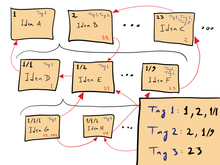Zettelkasten
The zettelkasten (German: "slip box") is a knowledge management and note-taking method used in research and study.

.jpg)
Method
A zettelkasten consists of many individual notes with ideas and other short pieces of information that are taken down as they occur or are acquired. The notes are numbered hierarchically, so that new notes may be inserted at the appropriate place, and contain metadata to allow the note-taker to associate notes with each other. For example, notes may contain tags that describe key aspects of the note, and they may reference other notes. The numbering, metadata, format and structure of the notes is subject to variation depending on the specific method employed.
Creating and using a zettelkasten is made easier by taking the notes down digitally and using appropriate knowledge management software. But it can be and has long been done on paper using index cards.
The method does not only allow a researcher to store and retrieve information related to their research, but it is also intended to enhance creativity. Cross-referencing notes through tags allows the researcher to perceive connections and relationships between individual items of information that may not be apparent in isolation. These emergent aspects of the method make the zettelkasten somewhat similar to a neural network with which one may "converse".[1]
History
In the form of paper index cards in boxes, the zettelkasten (plural: Zettelkästen) has long been used by individual researchers and by organizations to manage information, including notably in the specialized form of the library catalog. It was pioneered by Conrad Gessner (1516–1565) and was described in detail by Johann Jacob Moser (1701–1785).[2] The 1794 idyll Leben des Quintus Fixlein by Jean Paul is structured according to the zettelkasten in which the protagonist keeps his autobiography.
One researcher famous for his extensive use of the method was the sociologist Niklas Luhmann (1927–1998). Luhmann built up a zettelkasten of some 90,000 index cards for his research, and credited it for enabling his extraordinarily prolific writing (including over 70 books and 400 scholarly articles).[3] His index cards were digitized and made available online in 2019.[4] Luhmann described the zettelkasten as part of his research into systems theory in the essay Kommunikation mit Zettelkästen.[5]
External links
- Zettelkasten.de, project dedicated on researching and developing the method.
- r/Zettelkasten's Zettelkasten, guide to getting started with the method.
References
- Mittelmann, Angelika (2019). Wissensmanagement wird digital. pp. 63–65. ISBN 9783749461219.
- Haarkötter, Hektor. "'Alles Wesentliche findet sich im Zettelkasten'". heise online (in German). Retrieved 2020-05-31.
- Clear, David. "'Zettelkasten — How One German Scholar Was So Freakishly Productive'". The Writing Cooperative. Retrieved 2020-06-24.
- Noack, Pit. "Missing Link: Luhmanns Denkmaschine endlich im Netz". heise online (in German). Retrieved 2020-05-31.
- Niklas Luhmann: Kommunikation mit Zettelkästen. Ein Erfahrungsbericht, in: André Kieserling (ed.), Universität als Milieu. Kleine Schriften, Haux, Bielefeld 1992, ISBN 3-925471-13-8, p. 53–61; translated in: "Communicating with Slip Boxes". luhmann.surge.sh. Retrieved 2020-05-31.